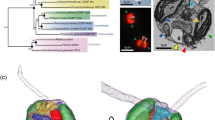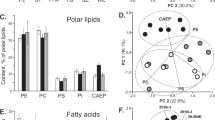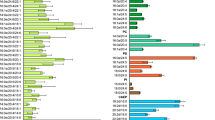Abstract
THE upper, biologically active, layers of Recent aquatic sediments contain considerable quantities of saturated and unsaturated long chain fatty acids1–3, presumsably from the living and dead organisms found there4,5. Although fatty acids are major constituents of organisms, in the upper layers of sediments, their concentration is of the same order of magnitude as that of sterols6,7, usually minor constituents of organisms. The ratio of fatty acids to total organic carbon in marine sediment is at least ten times lower than in plankton1, again indicating that fatty acids are subject to rapid changes in the sediment. Palmitic acid (C16:0) is the most abundant saturated fatty acid in organisms, and oleic acid (C18:1) the most widely distributed and plentiful of all fatty acids4,5. The lower, biologically less active, layers of sediments, contain little or no unsaturated fatty acid; palmitic acid is the most abundant of the fatty acids1,2,8. This difference between the upper and lower layers is unlikely to be the consequence simply of hydrogenation of the carbon–carbon double bands, for in this case the proportion of stearic acid (C18:0) in the lower layers and the concentrations of saturated fatty acids would be larger. These reactions could occur by chemical and/or biological means, perhaps through the large number of anaerobes present in upper layers of sediments9,10.
This is a preview of subscription content, access via your institution
Access options
Subscribe to this journal
Receive 51 print issues and online access
$199.00 per year
only $3.90 per issue
Buy this article
- Purchase on Springer Link
- Instant access to full article PDF
Prices may be subject to local taxes which are calculated during checkout
Similar content being viewed by others
References
Parker, P. L., and Leo, R. F., Science, 148, 373 (1965).
Peterson, D. H., thesis, Univ. Washington (1967).
Parker, P. L., in Organic Geochemistry (edit. by Eglinton, G., and Murphy, M. T. J.) (Springer, Berlin and Heidelberg, 1969).
Shorland, F. B., in Chemical Plant Taxonomy (edit. by Swain, T.) (Academic Press, London and New York, 1963).
Gunstone, F. D., An Introduction to the Chemistry and Bio-chemistry of Fatty Acids and their Glycerides (Chapman and Hall, London, 1967).
Parker, P. L., Contributions in Marine Science, 4 (1967).
Schwendinger, R. B., and Erdman, J. G., Science, 144, 1575 (1964).
Rosenfeld, W. D., Arch. Biochem. Biophys., 16, 263 (1948).
Oppenheimer, C. H., Geochim. Cosmochim. Acta, 19, 244 (1960).
Zobell, C. E., and Upham, H. C., Bull. Scripps Inst. Oceanog., 5, 239 (1944).
Lynen, F., Biochem. J., 102, 381 (1967).
Morris, L. J., Biochem. J., 118, 681 (1970).
Wakil, S. J., J. Lipid Res., 2, 1 (1960).
Rognstad, R., and Katz, J., Arch. Biochem. Biophys., 127, 437 (1968).
Dole, V. P., and Meinertz, H., J. Biol. Chem., 235, 2595 (1960).
Metcalfe, L. D., Schmitz, A. A., and Belka, J. R., Anal. Chem., 38, 514 (1966).
Morris, L. J., Chem. Ind., 1238 (1962).
Williams, M. A., Cope, G. H., Jackson, J. L., and Hill, P., Biochem. J., 118, 379 (1970).
Denton, R. M., and Randle, P. J., Biochem. J., 104, 423 (1967).
Mahler, H. R., and Cordes, E. H., Biological Chemistry (Harper and Row, New York, 1966).
Mead, J. F., and Levis, G. M., J. Biol. Chem., 238, 1634 (1963).
Hajra, A. K., and Radin, N. S., J. Lipid Res., 4, 270 (1963).
Farrington, J. W., and Quinn, J. G., Nature, 230, 67 (1971).
Brogden, W. B., thesis, Univ. Florida (1968).
Godwin, H., The History of the British Flora (Cambridge University Press, Cambridge, 1956).
Cox, R. E., Maxwell, J. R., Eglinton, G., Pillinger, C. T., Ackman, R. G., and Hooper, S. N., Chem. Commun., 1639 (1970).
Henderson, W., Wollrab, V., and Eglinton, G., in Advances in Organic Geochemistry (edit. by Schenck, P. A., and Havenear, I.) (Pergamon, London, 1968).
Streibl, M., and Herout, V., in Organic Geochemistry (edit. by Eglinton, G., and Murphy, M. T. J.) (Springer, Berlin and Heidelberg, 1969).
Author information
Authors and Affiliations
Rights and permissions
About this article
Cite this article
RHEAD, M., EGLINTON, G., DRAFFAN, G. et al. Conversion of Oleic Acid to Saturated Fatty Acids in Severn Estuary Sediments. Nature 232, 327–330 (1971). https://doi.org/10.1038/232327a0
Received:
Revised:
Issue Date:
DOI: https://doi.org/10.1038/232327a0
This article is cited by
-
Assessment of the estuarine shoreline microplastics and mesoplastics of the River Itchen, Southampton (UK) for contaminants and for their interaction with invertebrate fauna
Environmental Science and Pollution Research (2023)
-
Sustainable Oxidative Cleavage of Vegetable Oils into Diacids by Organo‐Modified Molybdenum Oxide Heterogeneous Catalysts
Journal of the American Oil Chemists' Society (2017)
-
Ecological implications of fecal pellets produced by the Antarctic krill Euphausia superba in the Antarctic Ocean
Marine Biology (1986)
-
Ecological significance of salp fecal pellets collected by sediment traps in the eastern North Pacific
Marine Biology (1986)
-
Interfacial sediment and assessment of organic input from a highly productive water column
Nature (1983)
Comments
By submitting a comment you agree to abide by our Terms and Community Guidelines. If you find something abusive or that does not comply with our terms or guidelines please flag it as inappropriate.



